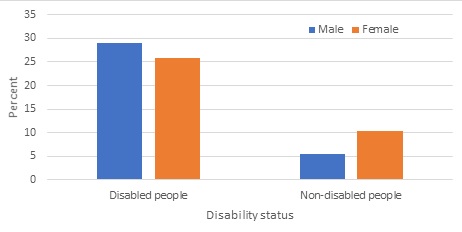Psychological distress is more common in disabled people
In 2020/21, nearly one in 10 adults aged 15 years and over (9.6 percent) had experienced psychological distress in the four weeks prior to taking part in the survey.
The proportion of disabled adults who experienced psychological distress in the past four weeks was 27.3 percent compared to 7.9 percent of non-disabled adults. After adjusting for age and gender, disabled adults were 4.6 times as likely to experience psychological distress as non-disabled adults.
The graph below shows that while both disabled males and disabled females were more likely to experience psychological distress than their non-disabled counterparts, the difference was greater for males.

Learn more
- This data was taken from the 2020/21 New Zealand Health Survey Annual Data Explorer
Definitions
'Psychological, or mental, distress' (aged 15+ years) refers to a person’s experience of symptoms such as anxiety, psychological fatigue, or depression in the past four weeks.
Psychological distress means having high or very high levels of psychological distress, with a score of 12 or more on the 10-question Kessler Psychological Distress Scale (K10). Where people have these levels of psychological distress, there is a high or very high probability that they also have an anxiety or depressive disorder.
Disability status was measured using a set of questions called the Washington Group Short Set (WGSS). 'Disabled people' are those who have a lot of difficulty with or can’t do the following at all: seeing or hearing (even with glasses or hearing aids), walking or climbing stairs, remembering or concentrating, self-care, or communicating. One of the limitations of the WGSS is that no question fully captures mental health impairments.
